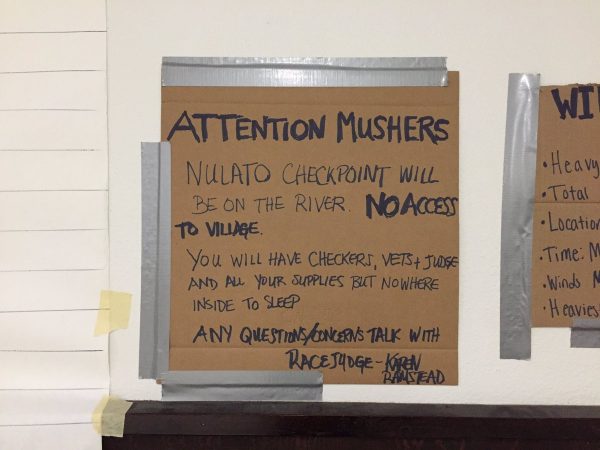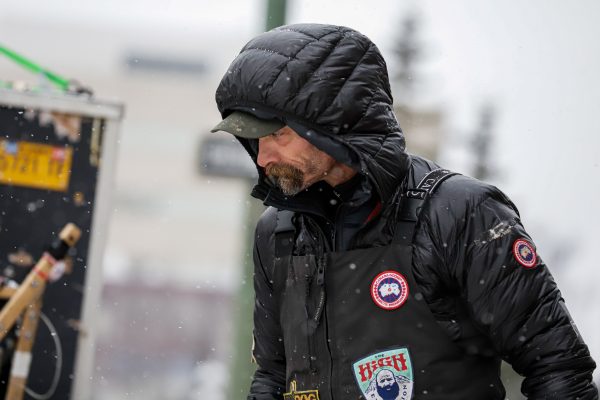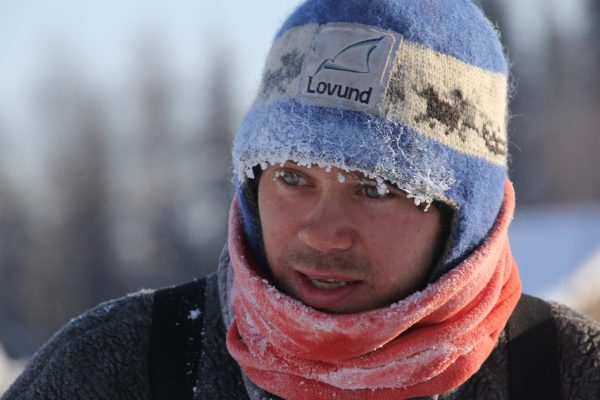
Galena — Iditarod race judge Karen Ramstead found herself in an unenviable position at the checkpoint here on Friday. She had to alert mushers that the checkpoint in the coastal town of Shaktoolik — about 200 away — would be shut down in the interest of public health.
She got a sharpie, some cardboard and scribbled a note.
“I’m just making a sign advising mushers that their supplies will be just outside of Shaktoolik for them, but they will not have any race personnel available to them,” she said.
Another message told mushers that the checkpoint in Nulato, the next stop on the trail, had also been moved outside of town, to a nearby river. Mushers can expect veterinarians and supplies, but “nowhere inside to sleep” and no access to the village, the sign said.
As Alaska confirms its first coronavirus case and shuts down its classrooms, the Iditarod is struggling to adjust. Schools, towns and checkpoints along the final third of the trail, including in Shaktoolik and Nulato, are limiting their involvement with the event. And that has major consequences for all involved, especially the mushers, who are having to modify their plans for racing a critical and competitive stretch of trail renown for its harsh conditions.
Related: While the coronavirus sidelines other sports, the Iditarod mushes on
The Bering Strait School District also announced Friday that it’s closing its facilities to visitors, including those associated with the Iditarod. Race officials are asking that fans not “make any nonessential travel to the Nome finish,” particularly those from out of state.
Ramstead, the race judge and herself a musher, wrote the message in Galena, and also shared the news in person.
Ramstead has competed in 11 Iditarods, and greeted many mushers by name as they pulled off the Yukon River into the checkpoint next to Galena’s community hall.

“Hey Lance, how’s it going?” she said as four-time Iditarod champion Lance Mackey arrived around 10 p.m. Friday.
“Hey I got some news for you that you may want to hear before you factor your plans ahead,” she told him. “Shaktoolik is not going to be a checkpoint anymore. What they’ve done is there’ll be a restock supply, all your HEET, straw, and food drops will be at Old Shaktoolik two miles this side of Shaktoolik. There will be no race personnel there at all, though.”
“Well that’s a little different,” Mackey said.
“Isn’t it? Ok, so just so you can start spinning the wheels,” she said.
For mushers, the checkpoint changes are bad news. The stretch up the coast from Unalakleet past Shaktoolik to Koyuk is notoriously windy, unpredictable, and harsh. Not having a checkpoint there means not having many options for shelter if conditions become extreme.

Joar Leifseth Ulsom, the 2018 Iditarod champion, was processing the news in Galena as he snacked on an egg roll.
“That definitely makes it a little interesting, being at that location is a safety checkpoint from weather and somewhere to get out of the wind and out of the elements on a long run from Unalakleet to Koyuk,” he said. “There’s nowhere really out there unless you get out to that shelter cabin, but that’s really exposed, and in bad weather you can’t get there. So hopefully we have good weather and a nice trip over.”
That’s another problem: There’s a storm warning for the region in effect until Sunday morning. The severity is an open question, but it’s far from ideal.
Related: Follow all of our coverage of the 2020 Iditarod here.
This is part of the race though. Mushers are expected to be able to adjust to new variables, even novel ones like these. Paige Drobny said she feels prepared for long, unsupported runs in extreme conditions from her experience on the Yukon Quest.
“As a Quest musher you’re out for 200 miles at a time with no checkpoint, so I can camp on the side of the trail to Nome with no checkpoint and that’s fine with me,” she said. “I mean, it’s a long way, especially with weather and stuff, between shelter cabins, but what are you gonna do?”
Race officials said they’re coordinating with Alaska’s chief medical officer to prevent the potential spread of the coronavirus. They’re also paring down staff along the trail to only essential personnel.
By Saturday morning, Brent Sass had taken over the Iditarod lead. There was a pack of mushers close behind, including Fairbanks musher Jessie Royer, Leifseth Ulsom and Aniak musher Richie Diehl.
Zachariah Hughes reports on city & state politics, arts & culture, drugs, and military affairs in Anchorage and South Central Alaska.
@ZachHughesAK About Zachariah




